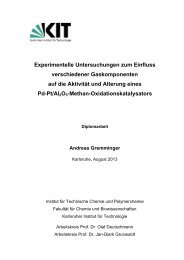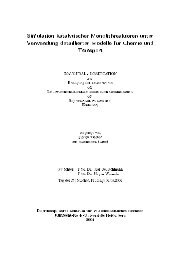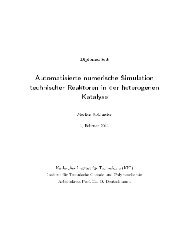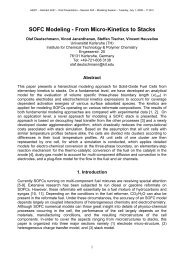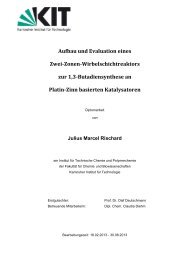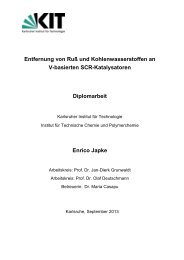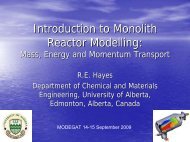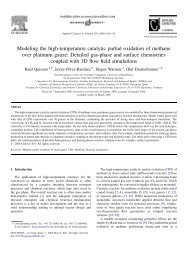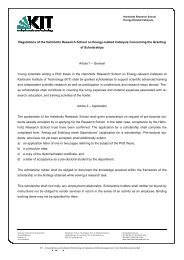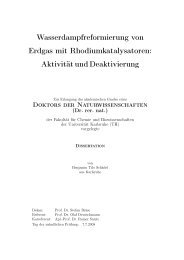Fuel Processing for Fuel Cells - Institut für Technische Chemie und ...
Fuel Processing for Fuel Cells - Institut für Technische Chemie und ...
Fuel Processing for Fuel Cells - Institut für Technische Chemie und ...
Create successful ePaper yourself
Turn your PDF publications into a flip-book with our unique Google optimized e-Paper software.
Author's personal copy<br />
52 Torsten Kaltschmitt and Olaf Deutschmann<br />
as fuel processing systems and fuel cells, which are located downstream<br />
of the CPOX reactor. Adequate measures are required to either avoid<br />
operation of the CPOX reactor in a regime where gas-phase reactions<br />
are likely to produce precursors of particulate matter, to reduce olefin<br />
concentrations with postcatalyst conversion strategies, or to collect the<br />
particles <strong>for</strong>med, <strong>for</strong> example, by means of the filters.<br />
Gas-phase-initiated coking of the product lines downstream of the<br />
catalytic section of the reactors, caused by the olefin precursors <strong>for</strong>med in<br />
the catalytic section, is the topic of a recent study (Kaltschmitt et al., 2011).<br />
The product composition of CPOX of iso-octane was chosen as the feed<br />
composition in a pure gas-phase experiment, in which the product stream<br />
was fed into an empty quartz tube heated up to a temperature typical <strong>for</strong><br />
the catalyst exit temperature of the CPOX reactor, in order to mimic the<br />
conditions downstream the catalyst. This homogeneous reactor was also<br />
modeled using two different large elementary-step reaction mechanisms.<br />
The study concluded that gas-phase reactions among a multitude of species<br />
are responsible <strong>for</strong> coke <strong>for</strong>mation when unconverted fuel leaves the hightemperature<br />
oxidation zone in the catalyst. Large amounts of olefinic<br />
hydrocarbons are initially <strong>for</strong>med by thermal cracking, leading to aromatic<br />
molecules and further downstream to PAH <strong>for</strong>mation (Figure 17). The<br />
presence of gas-phase reactions in the postcatalytic zone decreases the<br />
amount of hydrogen produced by methanation and hydrogenation of<br />
carbon monoxide and olefins, especially at fuel-rich conditions. Cracking<br />
of the remaining fuel increases the concentration of by-products (ethylene,<br />
acetylene, and C 3 –C 4 olefins) and, as a consequence, also increases the<br />
amount of carbon deposits. A conclusion of their study is that the experimentally<br />
determined yields (major as well as minor products) in laboratory<br />
CPOX reactors may deviate from the local yields at the catalyst exit,<br />
because the products cannot usually be quenched fast enough to avoid<br />
gaseous postreactions occurring within millimeters beyond the catalyst.<br />
7.3 Impact of the flow rate on re<strong>for</strong>ming efficiency<br />
In Figure 18, the impact of the flow rate on the temperature distribution in<br />
the monolithic sections of a short-contact-time reactor <strong>for</strong> the re<strong>for</strong>ming of<br />
iso-octane to hydrogen-rich synthesis gas reveals that higher flow rates<br />
lead to an increase in temperature and in conversion, and consequently<br />
lead to higher hydrogen yields (Maier et al., 2011a). This counter-intuitive<br />
increase in fuel conversion with decreasing residence time (increasing<br />
flow rate) can be explained by analyzing the ratio of chemical heat release<br />
to heat loss in the reactor (Hartmann et al., 2011). Maier et al. (2011a) have<br />
shown that choosing the right model to account <strong>for</strong> heat transfer in CPOX<br />
reactors helps to <strong>und</strong>erstand the impact of the flow rate on conversion



